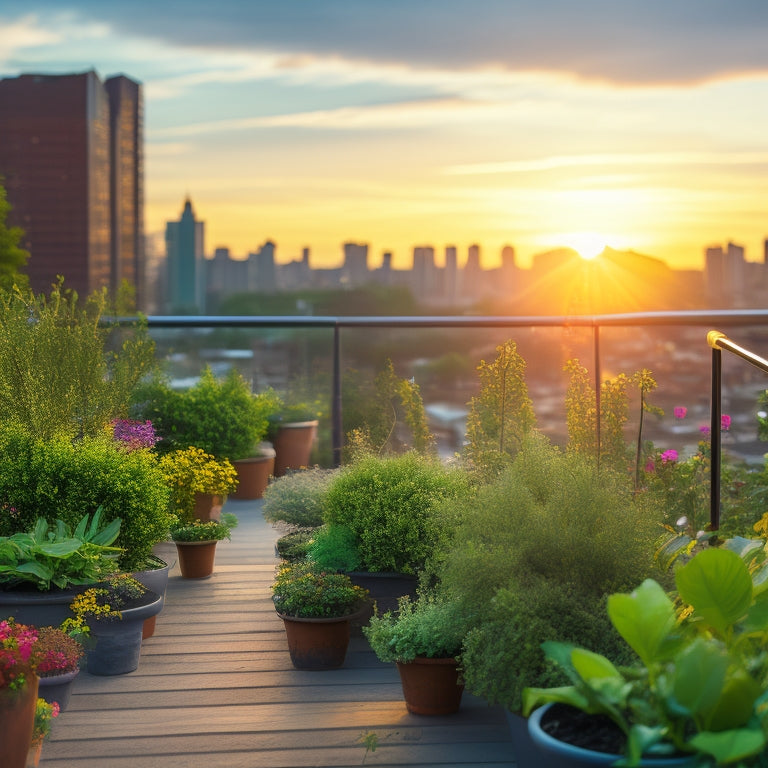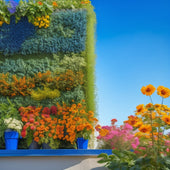
Setting Up Automatic Irrigation for Rooftop Gardens
Share
When designing an automatic irrigation system for your rooftop garden, assess the unique demands of your garden, including plant species, sunlight exposure, and soil type, to choose the right system. Visualize your garden layout to optimize irrigation and consider factors like evapotranspiration rate, climate conditions, and soil water-holding capacity. Select irrigation controllers and timers that adjust to weather data and soil moisture, and install a drip irrigation system tailored to your garden's needs. From here, you'll fine-tune your system with sensors, weather stations, and programming rules that guarantee your plants receive the perfect amount of water, and you'll be well on your way to creating a thriving rooftop oasis.
Key Takeaways
• Assess plant needs, including water requirements, sunlight exposure, and soil type to choose the right irrigation system for the rooftop garden.
• Calculate total water requirement based on plant species, evapotranspiration rate, climate conditions, and soil type to ensure optimal water delivery.
• Install a drip irrigation system with inline emitters, mini-sprinklers, or micro-sprinklers to reduce evaporation and runoff, and ensure efficient water distribution.
• Integrate irrigation controllers and timers with sensors and weather stations to optimize watering schedules based on real-time weather data and soil moisture levels.
• Regularly inspect and maintain the irrigation system to prevent leaks, blockages, and damage, and ensure it operates efficiently and effectively.
Choosing the Right Irrigation System
When selecting an irrigation system for your rooftop garden, consider the specific needs of your plants, including their water requirements, sunlight exposure, and soil type. This will help you choose the most efficient and effective system for your garden.
For instance, if you have plants with low water requirements, a drip tape system may be the best choice. This type of system delivers water directly to the roots of the plants, reducing evaporation and runoff.
On the other hand, if you have plants that require more water, a sprinkler system may be more suitable. However, be mindful of the sprinkler choice, as some may provide too much water, leading to waste.
Visualize the layout of your garden and consider the spacing of your plants to determine the best irrigation system for your specific needs. By taking these factors into account, you'll be able to create a tailored irrigation system that meets the unique demands of your rooftop garden, ensuring peak growth and water efficiency.
Assessing Rooftop Garden Water Needs
To accurately assess your rooftop garden's water needs, you'll need to calculate the total water requirement based on factors such as plant species, soil type, climate, and sunlight exposure.
Start by evaluating your plant selection, considering the water requirements of each species. Some plants, like succulents, are more drought-tolerant, while others, like ferns, require consistent moisture.
Next, examine your rooftop layout, taking note of areas that receive full sun, partial shade, or deep shade. This will help you determine the evapotranspiration rate, or how quickly water is lost through plant transpiration and soil evaporation.
Factor in your local climate, including temperature, humidity, and precipitation patterns. This will help you determine how often your rooftop garden needs watering.
Finally, consider the soil type and its water-holding capacity. Sandy soils drain quickly, while clay soils retain water longer.
Selecting Irrigation Controllers and Timers
By incorporating an irrigation controller and timer into your automatic irrigation system, you can precisely schedule water deliveries to your rooftop garden, ensuring that plants receive the right amount of moisture at the ideal time. This level of control is especially vital in rooftop gardens, where soil moisture can fluctuate rapidly.
When selecting an irrigation controller, look for features that align with your garden's specific needs. Take into account smart irrigation controllers that can adjust schedules based on weather data, soil moisture levels, and temperature. These advanced controllers can even be integrated with sensors and weather stations to optimize water usage.
Other key controller features to take into account include multiple zone control, customizable schedules, and manual override options. Some timers also come equipped with remote access capabilities, allowing you to adjust your irrigation schedule from anywhere.
Installing Drip Irrigation Systems
You'll need to map out your rooftop garden's irrigation layout before installing a drip irrigation system, identifying areas where plants require more water and pinpointing potential obstacles like downspouts or HVAC units. This will help you determine the ideal placement of drip emitters, which come in various types, such as inline emitters, mini-sprinklers, and micro-sprinklers. Each type is suited for specific plant types and soil conditions, so choose wisely.
When installing the drip irrigation system, use proper techniques to guarantee efficient water distribution. Start by laying out the mainline tubing, securing it with stakes or clips to prevent kinking or damage.
Next, attach the drip emitters to the mainline, spacing them according to the manufacturer's recommendations. Use barbed fittings to connect the emitters to the mainline, and make sure all connections are watertight.
Connecting Sensors and Weather Stations
As you set up your rooftop garden's automatic irrigation system, you'll need to connect sensors and weather stations to guarantee ideal water distribution.
You'll want to link soil moisture monitoring sensors to track the exact water needs of your plants, integrate weather data to account for precipitation and temperature fluctuations, and calibrate the sensors to guarantee accurate readings.
Soil Moisture Monitoring
What role do soil moisture sensors play in rooftop garden irrigation, and how can they be integrated with weather stations to optimize water usage? As a rooftop gardener, you want to guarantee your plants receive the right amount of water. Soil moisture sensors help you achieve this by monitoring the moisture levels in the soil. There are two main types of sensors: resistive and capacitive. Resistive sensors measure the electrical resistance between two electrodes, which changes based on soil moisture. Capacitive sensors, on the other hand, measure the capacitance between two electrodes, which is affected by soil moisture.
| Sensor Type | Moisture Retention |
|---|---|
| Resistive | Measures electrical resistance, suitable for sandy soils |
| Capacitive | Measures capacitance, suitable for clay soils |
| Tensiometric | Measures soil water tension, suitable for most soil types |
Weather Data Integration
By integrating soil moisture sensors with weather stations, rooftop gardeners can analyze real-time weather data to optimize irrigation schedules and ensure their plants receive the right amount of water. This integration enables you to access precise weather data, including temperature, humidity, and precipitation rates, to fine-tune your irrigation system.
With weather prediction capabilities, you can anticipate and prepare for extreme weather conditions, guaranteeing your plants are always watered correctly.
To maintain data accuracy, it's important to connect your weather station to a reliable and precise weather service. This will provide you with accurate forecasts, allowing you to adjust your irrigation schedule accordingly.
By combining soil moisture data with weather forecasts, you can create a tailored irrigation plan that takes into account the specific needs of your plants and the local climate. With this level of control, you can rest assured that your rooftop garden will thrive, even in the face of unpredictable weather conditions.
Sensor Calibration Process
You'll need to calibrate your soil moisture sensors and weather stations to guarantee seamless data exchange and accurate readings. This process involves adjusting the sensor settings to match the specific conditions of your rooftop garden.
Start by determining the type of sensor you're using, as different sensor types require unique calibration techniques. For instance, tensiometers measure soil moisture tension, while resistive sensors measure electrical conductivity.
Next, choose a calibration technique that suits your sensor type. The most common methods include the gravimetric method, which involves comparing sensor readings to actual soil moisture levels, and the empirical method, which relies on historical data to adjust sensor settings.
Once you've selected a technique, follow the manufacturer's instructions to calibrate your sensors. This may involve taking multiple readings, adjusting the sensor's sensitivity, and testing its accuracy.
Remember to recalibrate your sensors regularly to ascertain continued accuracy. This is especially important after changes in soil composition, weather patterns, or sensor placement.
Programming Watering Schedules Effectively
When programming watering schedules effectively, you'll need to set rules for watering frequency, adjust moisture sensor settings, and configure rainfall delay options.
These settings will work together to guarantee your rooftop garden receives the right amount of water at the right time.
Watering Frequency Rules
To guarantee ideal plant growth and water efficiency, programming a rooftop garden's automatic irrigation system requires adhering to specific watering frequency rules that account for factors like soil moisture, plant species, and climate conditions.
You'll need to tailor your watering schedule to the unique needs of your plants. For instance, succulents and cacti require less frequent watering than ferns and peace lilies. Consider the soil type, too - sandy soils dry out faster than clay or loam.
When selecting watering techniques, you'll want to balance water delivery with plant uptake rates. Drip irrigation, for example, provides a slow and steady supply of water directly to the roots, reducing evaporation and runoff.
Meanwhile, sprinkler systems are better suited for plants with shallower roots. By understanding the watering needs of your plant types, you can program your irrigation system to deliver the right amount of water at the right time, ensuring healthy growth and minimizing waste.
Moisture Sensor Settings
How do you guarantee your rooftop garden's automatic irrigation system delivers water precisely when it's needed, and in what quantities, to optimize plant growth and water efficiency? The answer lies in setting up your moisture sensor correctly.
This sensor measures the soil's moisture retention, allowing your system to adjust watering schedules accordingly. To get it right, you'll need to take into account factors like sensor placement, soil type, and plant species.
For instance, if you're using a soil probe sensor, place it 2-3 inches deep in the soil, avoiding areas with standing water or where water tends to collect. This guarantees the sensor is measuring the soil's moisture levels accurately.
Next, program your system to water when the soil moisture levels drop below a certain threshold, taking into account the specific moisture retention characteristics of your soil and plants. By doing so, you'll guarantee your rooftop garden receives the right amount of water, exactly when it needs it, resulting in healthy plant growth and optimized water usage.
With precise moisture sensor settings, you'll have complete control over your irrigation system, minimizing waste and maximizing results.
Rainfall Delay Options
By incorporating rainfall delay options into your automatic irrigation system, you can skip or postpone scheduled waterings for a set period after a significant rainfall event. This ensures your rooftop garden doesn't receive excess water. This feature is particularly useful when you're away from your garden for an extended period, as it prevents overwatering and reduces the risk of waterlogged soil. You can set the delay period based on the amount of rainfall received, ensuring your plants receive the right amount of water.
When setting up your rainfall delay options, consider the type of plants you have in your rooftop garden. For drought-resistant plants, you may want to set a longer delay period to allow them to absorb the rainwater before resuming irrigation. On the other hand, plants that require frequent watering may need a shorter delay period.
Additionally, if you have a rainwater harvesting system, you can use the collected rainwater to supplement your irrigation system, reducing your reliance on municipal water supplies. By fine-tuning your rainfall delay options, you can create a tailored watering schedule that meets the unique needs of your rooftop garden.
Maintaining and Troubleshooting Issues
Regular checks and maintenance are essential for guaranteeing your rooftop garden's automatic irrigation system operates efficiently and effectively, as even minor issues can lead to water waste, plant damage, or system failure.
You'll want to perform routine inspections to identify potential problems before they escalate. Start by checking the irrigation controller's programming and make sure it's set correctly. Next, inspect the irrigation lines, looking for signs of damage, kinking, or blockages. Confirm all connections are secure, and replace any worn-out or damaged components.
When it comes to irrigation maintenance tips, remember to flush the system regularly to remove debris and sediment. You should also check the water pressure and adjust it as needed to prevent leaks or system strain.
Speaking of leaks, troubleshooting them quickly is vital. Look for signs of moisture, water pooling, or uneven water distribution. Use a leak detector or inspect the system manually to identify the source of the leak.
Frequently Asked Questions
Can I Use a Single Irrigation System for Multiple Rooftop Gardens?
You can use a single irrigation system for multiple rooftop gardens if you design it with shared water sources and implement multi-zone management, allowing you to control and customize watering schedules for each garden separately.
How Often Should I Inspect and Clean My Irrigation System?
'You'll be shocked at how fast debris accumulates! Inspect your irrigation system weekly, and clean it monthly to prevent clogs and guarantee peak performance. Regular irrigation maintenance and system troubleshooting will save you from costly repairs and crop damage.'
Are There Any Special Considerations for Rooftop Gardens in Windy Areas?
When creating a rooftop oasis in windy areas, you'll want to choose wind-resistant plants and strategically place your irrigation system to minimize water loss and optimize coverage, ensuring your garden thrives despite harsh conditions.
Can I Integrate My Irrigation System With Existing Smart Home Devices?
You'll love that your smart home system can seamlessly integrate with your irrigation setup. For instance, imagine controlling your sprinklers with voice commands via Amazon Alexa, thanks to smart device compatibility and irrigation app integration.
Are There Any Local Regulations or Permits Required for Rooftop Irrigation Systems?
You'll need to research local codes and ordinances governing rooftop irrigation systems, as they vary widely, and navigate the permit process, which may involve inspections, approvals, and fees, to guarantee compliance.
Related Posts
-

3 Best Tool Essentials for Creative Concrete Planters
To create visually stunning and durable concrete planters, you'll need three essential tool categories. First, you'll...
-

3 Best Tool Essentials for Creative Concrete Planters
To create visually stunning and durable concrete planters, you'll need three essential tool categories. First, you'll...
-

3 Best Tool Essentials for Creative Concrete Planters
To create visually stunning and durable concrete planters, you'll need three essential tool categories. First, you'll...
-

3 Best Tool Essentials for Creative Concrete Planters
To create visually stunning and durable concrete planters, you'll need three essential tool categories. First, you'll...
-

3 Best Tool Essentials for Creative Concrete Planters
To create visually stunning and durable concrete planters, you'll need three essential tool categories. First, you'll...
-

3 Best Tool Essentials for Creative Concrete Planters
To create visually stunning and durable concrete planters, you'll need three essential tool categories. First, you'll...
-

3 Best Tool Essentials for Creative Concrete Planters
To create visually stunning and durable concrete planters, you'll need three essential tool categories. First, you'll...
-

3 Best Tool Essentials for Creative Concrete Planters
To create visually stunning and durable concrete planters, you'll need three essential tool categories. First, you'll...
-

3 Best Tool Essentials for Creative Concrete Planters
To create visually stunning and durable concrete planters, you'll need three essential tool categories. First, you'll...
-

3 Best Tool Essentials for Creative Concrete Planters
To create visually stunning and durable concrete planters, you'll need three essential tool categories. First, you'll...
-

3 Best Tool Essentials for Creative Concrete Planters
To create visually stunning and durable concrete planters, you'll need three essential tool categories. First, you'll...
-

3 Best Tool Essentials for Creative Concrete Planters
To create visually stunning and durable concrete planters, you'll need three essential tool categories. First, you'll...
-

3 Best Tool Essentials for Creative Concrete Planters
To create visually stunning and durable concrete planters, you'll need three essential tool categories. First, you'll...
-

3 Best Tool Essentials for Creative Concrete Planters
To create visually stunning and durable concrete planters, you'll need three essential tool categories. First, you'll...
-

Accurate Measuring for DIY Block Planters Made Easy
As you begin building a DIY block planter, precise measurement is essential for a sturdy structure that can support s...
-

Accurate Measuring for DIY Block Planters Made Easy
As you begin building a DIY block planter, precise measurement is essential for a sturdy structure that can support s...
-

Accurate Measuring for DIY Block Planters Made Easy
As you begin building a DIY block planter, precise measurement is essential for a sturdy structure that can support s...
-

Accurate Measuring for DIY Block Planters Made Easy
As you begin building a DIY block planter, precise measurement is essential for a sturdy structure that can support s...
-

Accurate Measuring for DIY Block Planters Made Easy
As you begin building a DIY block planter, precise measurement is essential for a sturdy structure that can support s...
-

Accurate Measuring for DIY Block Planters Made Easy
As you begin building a DIY block planter, precise measurement is essential for a sturdy structure that can support s...
-

Accurate Measuring for DIY Block Planters Made Easy
As you begin building a DIY block planter, precise measurement is essential for a sturdy structure that can support s...
-

Accurate Measuring for DIY Block Planters Made Easy
As you begin building a DIY block planter, precise measurement is essential for a sturdy structure that can support s...
-

Accurate Measuring for DIY Block Planters Made Easy
As you begin building a DIY block planter, precise measurement is essential for a sturdy structure that can support s...
-

Accurate Measuring for DIY Block Planters Made Easy
As you begin building a DIY block planter, precise measurement is essential for a sturdy structure that can support s...
-

Accurate Measuring for DIY Block Planters Made Easy
As you begin building a DIY block planter, precise measurement is essential for a sturdy structure that can support s...
-

Accurate Measuring for DIY Block Planters Made Easy
As you begin building a DIY block planter, precise measurement is essential for a sturdy structure that can support s...
-

Accurate Measuring for DIY Block Planters Made Easy
As you begin building a DIY block planter, precise measurement is essential for a sturdy structure that can support s...
-

Accurate Measuring for DIY Block Planters Made Easy
As you begin building a DIY block planter, precise measurement is essential for a sturdy structure that can support s...
-

Accurate Measuring for DIY Block Planters Made Easy
As you begin building a DIY block planter, precise measurement is essential for a sturdy structure that can support s...
-

Accurate Measuring for DIY Block Planters Made Easy
As you begin building a DIY block planter, precise measurement is essential for a sturdy structure that can support s...
-

Accurate Measuring for DIY Block Planters Made Easy
As you begin building a DIY block planter, precise measurement is essential for a sturdy structure that can support s...
-

Accurate Measuring for DIY Block Planters Made Easy
As you begin building a DIY block planter, precise measurement is essential for a sturdy structure that can support s...
-

Accurate Measuring for DIY Block Planters Made Easy
As you begin building a DIY block planter, precise measurement is essential for a sturdy structure that can support s...
-

Accurate Measuring for DIY Block Planters Made Easy
As you begin building a DIY block planter, precise measurement is essential for a sturdy structure that can support s...
-

Accurate Measuring for DIY Block Planters Made Easy
As you begin building a DIY block planter, precise measurement is essential for a sturdy structure that can support s...
-

Accurate Measuring for DIY Block Planters Made Easy
As you begin building a DIY block planter, precise measurement is essential for a sturdy structure that can support s...
-

Accurate Measuring for DIY Block Planters Made Easy
As you begin building a DIY block planter, precise measurement is essential for a sturdy structure that can support s...
-

Accurate Measuring for DIY Block Planters Made Easy
As you begin building a DIY block planter, precise measurement is essential for a sturdy structure that can support s...
-

Accurate Measuring for DIY Block Planters Made Easy
As you begin building a DIY block planter, precise measurement is essential for a sturdy structure that can support s...
-

Accurate Measuring for DIY Block Planters Made Easy
As you begin building a DIY block planter, precise measurement is essential for a sturdy structure that can support s...
-

Accurate Measuring for DIY Block Planters Made Easy
As you begin building a DIY block planter, precise measurement is essential for a sturdy structure that can support s...
-

5 Tips for Thriving Vertical Vegetable Gardens
To thrive in vertical vegetable gardening, you'll want to choose a planter that meets the unique needs of your veggie...
-

5 Tips for Thriving Vertical Vegetable Gardens
To thrive in vertical vegetable gardening, you'll want to choose a planter that meets the unique needs of your veggie...
-

5 Tips for Thriving Vertical Vegetable Gardens
To thrive in vertical vegetable gardening, you'll want to choose a planter that meets the unique needs of your veggie...
-

5 Tips for Thriving Vertical Vegetable Gardens
To thrive in vertical vegetable gardening, you'll want to choose a planter that meets the unique needs of your veggie...
-

5 Tips for Thriving Vertical Vegetable Gardens
To thrive in vertical vegetable gardening, you'll want to choose a planter that meets the unique needs of your veggie...
-

5 Tips for Thriving Vertical Vegetable Gardens
To thrive in vertical vegetable gardening, you'll want to choose a planter that meets the unique needs of your veggie...
-

5 Tips for Thriving Vertical Vegetable Gardens
To thrive in vertical vegetable gardening, you'll want to choose a planter that meets the unique needs of your veggie...
-

5 Tips for Thriving Vertical Vegetable Gardens
To thrive in vertical vegetable gardening, you'll want to choose a planter that meets the unique needs of your veggie...
-

5 Tips for Thriving Vertical Vegetable Gardens
To thrive in vertical vegetable gardening, you'll want to choose a planter that meets the unique needs of your veggie...
-

5 Tips for Thriving Vertical Vegetable Gardens
To thrive in vertical vegetable gardening, you'll want to choose a planter that meets the unique needs of your veggie...
-

5 Tips for Thriving Vertical Vegetable Gardens
To thrive in vertical vegetable gardening, you'll want to choose a planter that meets the unique needs of your veggie...
-

5 Tips for Thriving Vertical Vegetable Gardens
To thrive in vertical vegetable gardening, you'll want to choose a planter that meets the unique needs of your veggie...
-

5 Tips for Thriving Vertical Vegetable Gardens
To thrive in vertical vegetable gardening, you'll want to choose a planter that meets the unique needs of your veggie...
-

5 Tips for Thriving Vertical Vegetable Gardens
To thrive in vertical vegetable gardening, you'll want to choose a planter that meets the unique needs of your veggie...
-

5 Tips for Thriving Vertical Vegetable Gardens
To thrive in vertical vegetable gardening, you'll want to choose a planter that meets the unique needs of your veggie...
-

5 Tips for Thriving Vertical Vegetable Gardens
To thrive in vertical vegetable gardening, you'll want to choose a planter that meets the unique needs of your veggie...
-

5 Tips for Thriving Vertical Vegetable Gardens
To thrive in vertical vegetable gardening, you'll want to choose a planter that meets the unique needs of your veggie...


